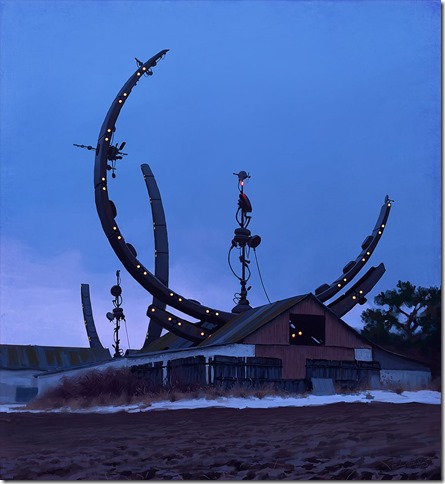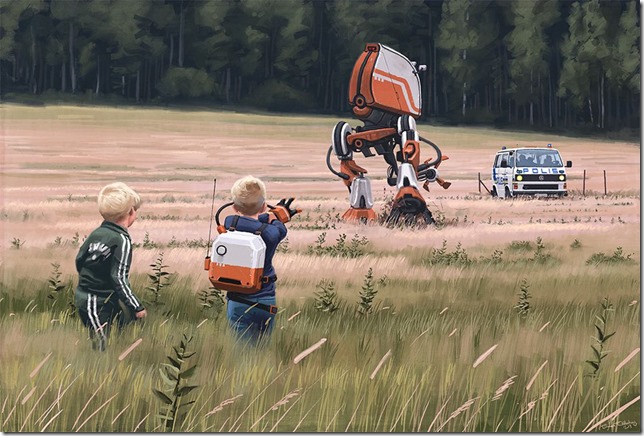 I don’t remember when I first learned about Simon Stålenhag‘s work. It might have been the article from The Verge in 2013, or a random blog post I stumbled upon while aimlessly surfing the web. What I remember is that I thought someone should create a roleplaying game based on these images. Simon Stålenhag’s art shows the ‘80s that never was. A world where the mundane reality of that decade meets the extraordinary. The protagonists in these pictures were often kids, perhaps 10 to 12 years old. Exactly the same age I was back in the mid ‘80s. Perhaps it’s what makes his art so compelling, he shows the years of my youth exactly as I wished they had been.
I don’t remember when I first learned about Simon Stålenhag‘s work. It might have been the article from The Verge in 2013, or a random blog post I stumbled upon while aimlessly surfing the web. What I remember is that I thought someone should create a roleplaying game based on these images. Simon Stålenhag’s art shows the ‘80s that never was. A world where the mundane reality of that decade meets the extraordinary. The protagonists in these pictures were often kids, perhaps 10 to 12 years old. Exactly the same age I was back in the mid ‘80s. Perhaps it’s what makes his art so compelling, he shows the years of my youth exactly as I wished they had been.
In 2016 Fria Ligan, the Swedish publisher behind games like Mutant: Year Zero and Coriolis, joined forces with Simon to create a roleplaying game based on his works. The Kickstarter campaign for the Tales From The Loop RPG was unsurprisingly highly successful. A lot of gamers had just watched the Netflix series Stranger Things which was about a group of kids confronted with technology gone awry, and a world stranger than we deemed possible. The time was definitely right for the Tales From The Loop RPG!
Disclaimer: This review is based on the digital edition which I got from Modiphius as a complementary copy. Thanks again, Chris!
Tales From The Loop is definitely one of the most gorgeous roleplaying game books I ever laid my eyes on. One reason is definitely Simon Stålenhag’s artwork, but the layout is another highlight of the 196-paged book. I can’t put my finger on it, but the whole look of the book seems to shout “1980s!”. And I mean that in a good way. It’s definitely easy on the eyes, the readability is high, and it’s very printer-friendly.
Welcome to the Loop
So what is Tales From The Loop about? In the alternative history of the game some highly advanced technologies like fusion, particle accelerators and the “magnetrine effect” were discovered in the 1950s which totally changed the world. Things deemed impossible until then were suddenly a reality. There are huge flying vessels, time travel, robots – and this is just the tip of the iceberg.
The 1980s presented in Tales From The Loop are a lot like we remember them, but still vastly different. In the game players take on the role of kids exploring this strange world, but while still being stuck in their everyday lives. Even though there’s something strange going on in the woods behind your house, your parents still want you to do your homework or bring out the trash first.
Adults in general are both out of reach and out of touch. They don’t believe your stories about dinosaur tracks on the field, or the crashed flying vessel your friends and you want to explore. They are more concerned about boring adult stuff like their job and money than the adventure which lurks just outside the door.
Same but different
The “1980s that never was” setting itself helps to set Tales apart from a lot other roleplaying games out there, but it also has a few other principles which make the game somewhat different than other games. For example the Kids (aka the player characters) never die in Tales. They can get in trouble, but they’ll survive all their adventures. Another principle is that the game is played scene by scene while leaving the boring parts out. You don’t need to play out the travel from one place to the other if nothing important happens. Last but not least the world is described collaboratively. Like in many games with a narrative focus the GM in Tales can delegate some of the world building to the players. But while the players may help create the mundane parts of the world, the mysteries are firmly in the hand of the GM, just as in any traditional RPG.
Stranger Things
The game comes with two settings: Boulder City, Nevada, and Mälaren Islands, Sweden, which are the locations of huge experimental particle accelerators aka the Loops. But the game also allows for the GM and players to create their own setting based on their own hometowns.
Both settings are described in a lot of detail. Personally I find the Swedish setting more interesting, probably because it’s a welcome change from the americacentrism in most roleplaying games. Aside from geographic information you also get information on how it felt to grow up in the area during the ‘80s. There are examples on what kids back in the day did to waste their free time. If you are in your 40s like I am, you’ll probably feel nostalgic more than once while reading about Commodore 64 games, VHS videos, and getting candies from the local kiosk.
The book also contains quite detailed and in my opinion very beautiful maps of both areas. But let’s now have a look at the mechanics and what kind of characters you can actually play in Tales From The Loop.
The Kids
Like Coriolis Tales uses the game engine from Mutant: Year Zero (see my reviews of Coriolis and Mutant for more details). Like in Mutant there are a number of character Types which help to give your character a strong focus without being to restricting. Each Type has three key skills and examples for a character’s Iconic Item, Problem, Drive, and Pride, Anchor, as well as their relationships with other player characters or NPCs.
The available types are Bookworm, Computer Geek, Hick, Jock, Popular Kid, Rocker, Troublemaker, and Weirdo. After choosing your Type, you have to decide on your character’s age between 10 and 15 years. Your character’s age determines the amount of attribute points you can spend on Body, Tech, Heart, and Mind, and the number of Luck Points. Older kids have more attribute points to spend, but less luck, and vice versa.
The before mentioned Iconic item is a special item your character owns. It’s not just another piece of equipment, but something which tells something about its owner. This item never gets lost permanently and it also helps to overcome Trouble.
A character’s Problem, Drive, and Pride help to define your character’s … eh … character and also have some mechanic effects. You may for example use your Pride once per session to succeed a task automatically.
The Anchor is a person your character trusts and who you can go to for comfort, support, or care, It can be a friend, a relative, a teacher, a neighbour, pretty much anyone aside from another player character. The Anchor is also the NPC who can remove all Conditions from the character. A scene spent with the Anchor also never causes additional Trouble for the kids – it’s their safe place.
Instead of having hitpoint like in other games, Tales uses Conditions like Upset, Scared, Exhausted, Injured and Broken. If the Kids try to overcome Trouble and fail or if you push a dice roll, you are forced to take a Condition. When suffering from a Condition you have a pool modifier of –1 or in the case of Broken you fail all checks automatically.
The Dice
Ok, let’s talk about the dice mechanics now. If you already know Mutant or Coriolis this should sound quite familiar: to make a check you add a number of dice to your pool equal to the skill in question and the corresponding attribute. Then roll the dice. Each die which comes up six is a success. Usually one success is sufficient to overcome most Trouble, but just barely. If you fail, your character may suffer harm in form of a Condition. Luck points can be used to reroll failed dice. You can also decide to push yourself. Pushing also let’s you reroll dice which didn’t show successes, but it also forces you to pick an appropriate Condition.
If you roll more successes than needed you can opt for buying effects. Each skill has a list of effects you can buy. Often these effects allow you to provide support to other Kids, impress others or achieve more than you hoped for.
Overall the rules in Tales have a much bigger narrative focus than those in the other games I mentioned earlier. There are no complex combat rules – it’s a game about kids after all – and instead everything is kept simple. Even though the target audience for Tales is probably people in their early to mid 40s basking in nostalgia, it’s a game you could easily play with real kids. But I doubt they might get all the ‘80s references…
The Mystery
Chapter 6 of Tales From The Loop is called “The Mystery” and it’s basically the GM section. Here’s where you get guidelines on how to setup and run scenes, how to tell a typical Tales mystery. The typical adventure or Mystery in Tales From the Loop consists of six phases: Introducing the Kids, Introducing the Mystery, Solving the Mystery, Showdown, Aftermath, and Change. Each phase is explained in detail and supported by examples. There is also advice given on how to design bigger mysteries and whole campaigns.
The Mystery Landscape
Chapter 7 of the book provides another way of running Tales: the Mystery Landscape. This is actually a guide to a sandbox campaign including an example sandbox for you to play in. The included example sandbox is set on Mälaren Islands and consists of descriptions of the various points of interest in the area complete with story hooks and NPCs. Especially more proactive players can get a lot of enjoyment from sandbox campaigns and I think Tales is a perfect fit for this kind of campaign. Especially since the player characters are kids with a limited travel range, which helps to prevent them “breaking” out of the sandbox.
The Four Seasons of Mad Science
The last 80 pages or so of the book consist of four read-to-play mysteries set on the Mälaren Islands (or near Boulder City). The first three mysteries can be played in about one session, while the last one is much longer. The mysteries can be played in succession as a campaign. One brilliant thing the authors did was create the mysteries in such a way that they can played in both settings.
Conclusion
 Tales From The Loop is without a doubt a brilliant roleplaying game. The alternative history setting evoked by Simon Stålenhag’s artwork is exciting, mysterious, and full of nostalgia for the ‘80s, the rules are very easy to learn and to use, and fit a game about kids perfectly. The only issue I can imagine is that some players might be intrigued by the setting, but not some of the game’s premises. Playing 10-15 year-olds is not everyone’s cup of tea. But even then, I recommend you give Tales From The Loop a chance. It might also be a good system for people new to roleplaying or who want to run a game for their own kids. So, what are you waiting for? Get up and buy a copy of Tales From The Loop now!
Tales From The Loop is without a doubt a brilliant roleplaying game. The alternative history setting evoked by Simon Stålenhag’s artwork is exciting, mysterious, and full of nostalgia for the ‘80s, the rules are very easy to learn and to use, and fit a game about kids perfectly. The only issue I can imagine is that some players might be intrigued by the setting, but not some of the game’s premises. Playing 10-15 year-olds is not everyone’s cup of tea. But even then, I recommend you give Tales From The Loop a chance. It might also be a good system for people new to roleplaying or who want to run a game for their own kids. So, what are you waiting for? Get up and buy a copy of Tales From The Loop now!
The game is available in print and PDF from the Modiphius store, or digitally on DriveThruRPG. Alternatively you might get it at your favorite local dealer. The PDF sets you back about €23, the hardcopy costs about €40.









I kinda wish MYZ (because it’s the game-development predecessor to MC, though they diverged quite a bit between the original MYZ and the original Mutant Chronicles), and thus Coriolis and Tales from the Loop, were all using the same “2d20” system that MC, Conan, and Star Trek are using. Do you have any thoughts about comparison/contrast between the two systems?
I actually prefer the d6 pool system used in Tales, Mutant, and Coriolis since it’s way lighter. 2d20 is definitely not a bad system, and I enjoyed its implementation in Modiphius’ Star Trek game a lot. But as you may well know I am a sucker for rules-light games, and the Mutant engine definitely fits the bill.